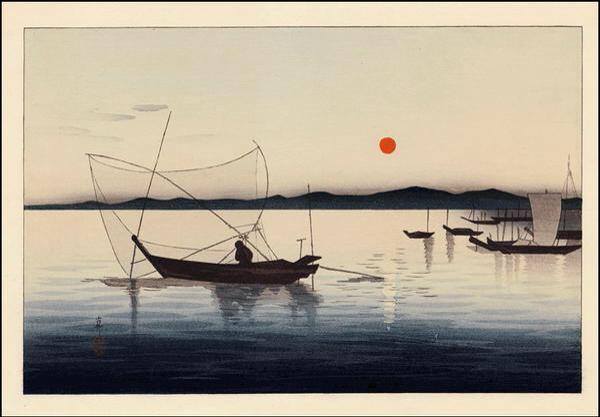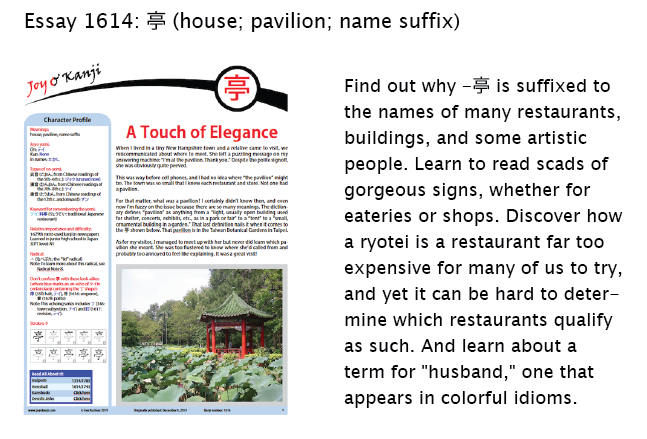The Lure of the Bait
I just read an ultra-serious article about a bleak social problem that a former classmate is confronting in the courts. On Facebook, several of my peers left sober, mature comments about the severity of the issue, but the kid in me couldn't stop being amused by one unintended pun. The article showed how a villain named Anglin caused trouble in a town called Whitefish.
For some reason, I keep coming across fish material, which I'll share here.
Cormorant Fishing
In writing the new essay 1614 on 亭 (house; pavilion; name suffix), I learned that a Japanese husband might refer to his lot in life with this self-mocking term:
鵜飼いの鵜 (うかいのう) cormorant fishing (1st 2 kanji) + cormorant
As I wrote in essay 2103 on 阜 (hill), cormorant fishing involves trained cormorants that catch sweetfish, storing up to six in their throats. Ropes around the throat prevent the birds from swallowing the fish, which the cormorants then spit back up for human consumption! In fact, the imperial family dines on some of these regurgitated fish each year!
Just as a cormorant (represented by the non-Joyo 鵜) works hard to capture fish, only to give them all to the fisherman, a Japanese husband can keep very little of his own salary. He traditionally hands it over to his wife, who gives him only a small allowance each week.
A Public Fish
What kind of fish do you think this might be:
公魚 (わかさぎ) public + fish
I'll block the answer with artwork that will be a century old in 2020! Fishing Boats at Dusk is by 小原祥邨 (おはら しょうそん, 1877–1945), in which 邨 is non-Joyo:

The answer is that 公魚 (わかさぎ: public + fish) means "Japanese pond smelt." Japanese Wikipedia says that back in the Edo era (1603–1867) the Aso clan in what is now northeastern Ibaraki Prefecture paid taxes in the form of this fish. The shogun Ienari Tokugawa loved it, so this smelt became the fish (魚) officially provided to the government (公)—hence the name.
Fish and Flowers
Some sea creature names contain flowers. Here's one:
薔薇笛鯛 (ばらふえだい: two-spot red snapper, Lutjanus bohar)
rose (1st 2 kanji) + star snapper (last 2 kanji)
Of the four kanji, only 笛 (woodwind instrument) is in the Joyo set. The first two characters mean "rose." The fish acquired the name thanks to the vivid red color of the flesh, which turns into a beautiful sashimi.
Two types of shrimp also have flowers in their names:
桜海老 (さくらえび: sakura shrimp, Sergia lucens) cherry + shrimp (last 2 kanji)
牡丹海老 (ぼたんえび: botan shrimp, Pandalus nipponensis)
tree peony (1st 2 kanji) + shrimp (last 2 kanji)
Again, color inspired these compounds. The pink body of a 桜海老 suggests cherry blossoms. And two theories about the 牡丹海老 exist: (1) red dots on the sides of the shrimp resemble peony petals or (2) the entire body is reddish, bringing a peony flower to mind.
As long as we're investigating interesting names from the sea, here's another:
北枕 (キタマクラ: brown-lined puffer, Canthigaster rivulata) north + pillow
This type of fish has poison in its skin, so if you feast on this animal, you'll end up lying with your head to the north. See essay 2115 on 枕 (pillow) to find out why that means you're dead!
The Lure of the Bait
Essay 2124 on 湧 (to well (up), spring forth, gush out; come out of nowhere; to form) contains another fishy surprise. I'm talking about this sentence, which features the keyword 湧き (わき) with the wonderfully specific definition "frothing of water (due to an advancing school of fish)":
餌につられて魚の大群が押し寄せた海面に湧きが広がる。
When the feed hit the water, the swarm of fish attempted to reach the food, making the surface of the sea froth more and more.
餌 (えさ: animal food); つられる (釣られる: to be lured); 魚 (さかな: fish); 大群 (たいぐん: large school); 押し寄せる (おしよせる: to swarm); 海面 (かいめん: surface of the sea); 広がる (ひろがる: to spread)
I wondered about つられて, which comes from つられる (釣られる: to be lured). Wouldn't it be better to write the つ in the sentence as 釣? No, said my proofreader. "If you write it as 釣, it sounds quite like the fish have already been caught. The つられて sounds more like they were just lured by the bait."
I know hiragana can seem warmer than kanji, but I have never in my life learned that the two types of renderings can convey the difference between life and death!
In this case, the issue is that the passive form of 釣られる (lit., "to have a fish be caught") has spun off its own figurative meaning ("to be lured"), which the Japanese use when talking about being drawn in by someone's words or behavior. Seeing 釣 makes people think of actual fishing—specifically with a rod, not with a large net (the tool likely used in the scenario above)—so the Japanese tend to write the passive form in hiragana.
See You in 2020!
That's it for JOK Notebook posts for 2019. I'll leave you with a sneak preview of essay 1614 on 亭 (house; pavilion; name suffix):
Catch you back here in the new year! Happy holidays to all!
❖❖❖
Did you like this post? Express your love by supporting Joy o' Kanji on Patreon:



Comments